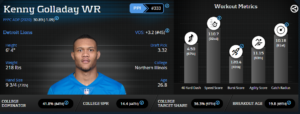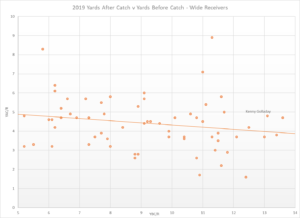Why Kenny Golladay Won’t Be A Top-12 Fantasy WR In 2020
Everywhere I look right now, I see people waxing lyrical about Kenny Golladay, ranking him as a top-10 fantasy Wide Receiver for 2020 and listing him with top 5 potential. But try as I might, I just can’t get him there.
It’s not going to be a popular opinion but I’m going to break down how I see things shaping up for him this year and the reasons why I think he won’t be a WR1.
The Case For
I’ve seen the guy play and he’s an absolute baller. There’s a reason why they call him Babytron, in homage to Calvin Johnson, and I’m going to enjoy watching him beat double coverage to snag the ball in seemingly impossible situations.
Related | Kenny Golladay: The NFL’s very own James Harden
In 2019 he was 4th in yards per reception, 1st in deep targets, and was one of only three players to get double-digit touchdowns. He was great, he got the ball downfield and he scored, what’s not to love.
And for those who love the measurables, 92nd percentile speed score, 81st percentile catch radius and 84th percentile college dominator.

I’ll also refer to Matt Harmon’s Reception Perception here where he has recently noted Golladay’s year-on-year improvement in success rate against man and press coverage, a metric which most receivers don’t significantly improve over time. Golladay is really, really good.
A deeper look at the numbers
Average Depth of Target (aDOT)
His aDOT in 2019 (14.6 yards) was 11th in the league, 9th amongst receivers who got more than 50 targets. But in 2018, his aDOT was 2.2 yards lower which put him down at 37th in the league. That’s a reasonable year-on-year increase so the questions to ask are:
- why did it jump?; and
- is it sustainable?
When you look at the 2019 gamelogs, there were two games in particular where Golladay’s aDOT was 28 or higher, that’s massive. They’re outlier numbers. If we bring those numbers back down to average, that would knock his season-long aDOT to 13.8 (25th in the league).
Catch Rate
His catch rate was 56-percent overall. In the games with Stafford only, he averaged 56.5-percent. When we look at his depth of target and expected catch rate on that basis, he’s slightly below average but he’s in the ball-park.
Nothing to see here.
Yards After Catch (YAC)
Now his YAC is where things get a little interesting. Golladay had a YAC of 4.7 yards per reception in 2019. That might not seem that high, but based on the depth of the targets, it is.
In 2018, Golladay’s YAC per reception was even higher, at 5.0, but his target depth was much lower. He’s clearly a player who can produce after the catch and we should expect his YAC to be above-average, but we can expect his 2019 rate to regress somewhat (I released an article a few weeks ago on YAC and regression where I talk more about the theory on this).
What Else?
Let’s take stock. Golladay’s aDOT was high and was skewed by a couple of big games so we can expect that to drop a little. His YAC was also high but he’s proven that he’s great after the catch and the eye-test backs that up, but we can probably expect a small regression back towards the mean here too.
If we conservatively take 1 yard per reception off his 2019 numbers, his total yards drop from 7th in the league to 18th. Even dropping by 0.5 yards takes him out of the top 12.
When you take in to account PPR leagues, things get even worse for Golladay. He’s not a high volume receiver like the top tiers, his 65 and 70 catches over the past two years were 42nd and 33rd in the league. In any kind of format where catches count, he takes a hit.
Touchdowns
Here’s where Golladay shone in 2019 and his Babytron mould will always make him a huge red zone threat. But for those that don’t know, touchdowns are not a repeatable and predictable statistic. Yes, some players are more likely to score than others, but they’ve volatile and relying on touchdowns for your fantasy production is futile. In 2019, two of the top receivers were Michael Thomas and Chris Godwin, who both scored 9 touchdowns each, two less than Golladay. If we’re generous and apply that to Golladay, he would have dropped to the edge of the top 12 in PPR leagues.
For some more context, Golladay’s 11 touchdowns came at a rate of 9.5-percent. In 2018, he scored at a rate of 4.2-percent and in 2017 at a rate of 6.3-percent. 9.5-percent is high.
For comparison:
- DeAndre Hopkins career touchdown rate – 5.2-percent
- Mike Evans career touchdown rate – 5.7-percent
- Terrell Owens career touchdown rate – 8.2-percent
- Randy Moss career touchdown rate – 9.0-percent
- Calvin Johnson career touchdown rate – 6.3-percent
See Where Kenny Golladay Lands In Our 2020 Fantasy Draft Rankings!
As you can see a 9.5-percent touchdown rate is not sustainable, even by some of the best in the game. So this will absolutely come down. If we were generous again and gave him a 7-percent touchdown rate (which is better than his previous two years, better than Calvin Johnson, better than Hopkins, better than Evans), this would have been a reduction to 8 touchdowns, which would have put him at WR16 in PPR.
I’m going to take stock again here. He finished 9th in PPR leagues in 2019 with a very high aDOT (which was skewed by a couple of big games) and a very high touchdown rate which is clearly unsustainable. So how does he get in to the top 5 or even maintain top 12?
The last piece of the puzzle is target volume.
Targets
Golladay got 21-percent of the targets in 2019. Marvin Jones, TJ Hockensen and Danny Amendola are still there and are still going to take their share of the targets. You can say what you like about Amendola but he’s the slot guy and will get plenty of targets. Stafford is not just going to start throwing every ball downfield for Golladay, no matter how capable he might seem.
Related | Why Marvin Jones Is A Great Buy For Any Dynasty Contender
TJ Hockensen is heading in to his second year and is expected to take a step-up, and the Lions have just added a capable pass-catching back in D’Andre Swift.
Unless the Lions are suddenly going to shift their playing style and go full Atlanta Falcons (which is extremely unlikely under Matt Patricia) then I don’t see a significant change in target volume for Golladay, outside of an injury. If he is going to get a significant target increase then he’s going to need to run some shorter routes and be more of a possession receiver. Not only is this not playing to Golladay’s strengths, his numbers would also be balanced out by the reduction in yardage metrics (lower yards-per-reception, etc).
I love Golladay, I really do. But I’m not prepared to bet on those unsustainably high metrics or a significant increase in volume without injury to one of his teammates.
If I can get him as a WR2 I’d be delighted, but there’s no chance Kenny Golladay is on the board where I’m willing to take him at this stage in the 2020 fantasy draft process.








